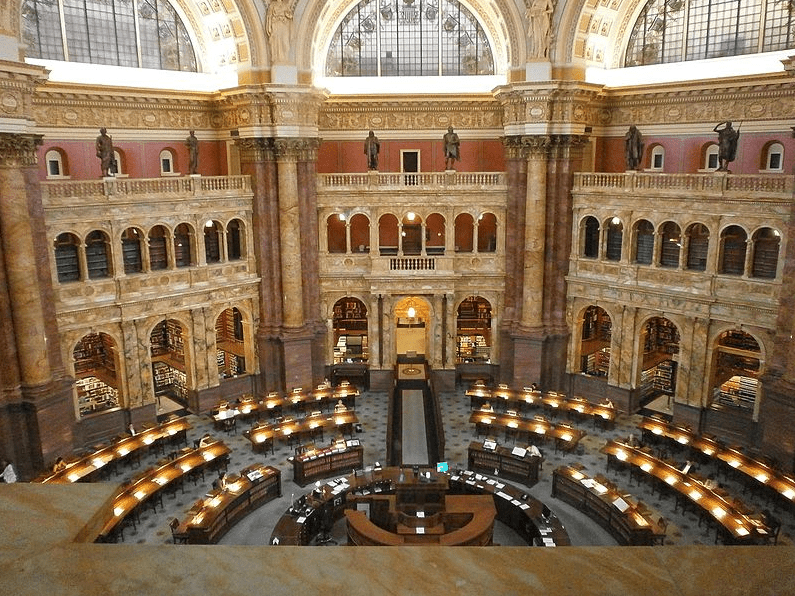The Library of Congress serves the U.S. Congress and is recognized as the national library in the country. It has long been a bastion of history, knowledge, and information since it was established in 1800. It is home to more than 38 million books and other printed material.
In addition to books, the Library of Congress contains millions of historical recordings, photographs, maps, sheet music, manuscripts, and other special collections.
And speaking of special collections, the Library of Congress has a broad range of pretty antiquated items that are less venerable but no less interesting. Here are some of them that will surely surprise and fascinate you:
1) Amelia Earheart’s palm print
Palmistry, or palm reading, is the practice of studying a person’s hand to interpret the individual’s personality. Nellie Simmons Meier, a socialite and celebrity palm reader, examined the hands of Amelia Earheart.
Earheart was the first woman to fly solo across the Atlantic in 1933, four years before her mysterious disappearance while flying over the Pacific Ocean. In Meier’s book, Lion’s Paws: The Story of Famous Hands, she wrote her findings of Earheart’s hand:
“The length of the palm indicates the love of physical activity, but the restraining influence shown by the length of the fingers, indicative of carefulness in detail, enables her to make careful preparation toward accomplishing a definite goal.”
2) Ira Gershwin’s home movies
The Library of Congress also possesses a number of rare amateur clips filmed by the late lyricist Ira Gershwin, which are a real treasure. They offer a more human and candid look at his Hollywood celebrity friends. Some home movies feature himself relaxing in an outdoor chair or his pianist/composer brother George eating by the poolside or working on a new portrait. Below is Gershwin’s 1948 home video of little Liza Minnelli’s birthday party:
You can watch also watch Gershwin’s other home videos on the Library of Congress website.
3) “The Office Boy” — the board game that preceded Monopoly
Long before Monopoly became the best-selling game in 1935, the Parker Brothers created an earlier board game, “The Office Boy.” Released in 1889, the goal of this game was to work one’s way up from a lowly stock boy to the head of the company.
While the game board itself is in the Library of Congress’ possession, the game’s playing pieces and the teetotum (a spinning toy with numbers) remain missing.
4) Locks of famous people’s hair
The Library of Congress also has a collection of hair, some of them belonging to famous celebrities and public figures, while others belonging to the ordinary folks but with interesting stories to tell.
The Library of Congress has samples of these locks of famous people, including Thomas Jefferson, James Madison, and Walt Whitman. Jeffersons’ locks were snipped off from his deathbed, while Whitman’s housekeeper cut off a few strands of his hair. Madison’s clippings are neatly kept in a braided pattern. If you like hair and history together, you’ve got to check them out.
5) The contents of Abraham Lincoln’s pockets when he was assassinated
One would wonder, if they do at all, about what was inside Abraham Lincoln’s pockets at the time of his assassination on April 14, 1865. Fortunately, you can see them on display at the Library of Contents, and… they’re no more different to those coming from an ordinary man’s pockets.
They include two pairs of glasses, a quartz-and-gold watch fob, a six-blade pocketknife, a linen handkerchief embroidered with “A. Lincoln” stitched in red, newspaper clippings, a glass cleaner, a case of the glasses mentioned earlier, and a wallet, which contained a Confederate $5 bill.
6) Thomas Jefferson’s vanilla ice cream recipe
While the claim that Thomas Jefferson brought ice cream to America is pure myth, he can be credited as the first American to write down the country’s earliest known ice cream recipe. For his fondness towards yummy things like ice cream, he might as well be considered as America’s first “foodie”!
Jefferson’s recipe for vanilla ice cream is highly detailed yet utterly natural — it calls for simple ingredients such as “good cream,” egg yolks, and sugar. To decipher this recipe, check out this link from IceCreamNation.org.
7) George Washington’s “rules of civility”
Even as a schoolboy in Virginia, George Washington knew he would be a great man someday. So, he took his first steps towards greatness by hand-copying a list of 110 “Rules of Civility & Decent Behavior in Company and Conversion.”
This lengthy code was based on a 16th-century set of rules or instructions compiled by Jesuit mentors for young men. Most of the rules concern all of the things that every decent young gentleman needs to know, from etiquette to matters of morality.
Of course, you can expect that some of the rules are outdated, and the language is somewhat stuffy. However, other rules are timeless and can be applied to the present day. Here’s an example: “Rinse not your mouth in the presence of others.” Or this one: “Labor to keep alive in your breast that little spark of celestial fire called conscience.”
While the Library of Congress houses a treasure trove of historical and cultural artifacts, it’s just one example of humanity’s dedication to preserving knowledge. Where Are the Oldest Libraries on Earth Located? takes you on a journey to discover the origins of this tradition, exploring the ancient libraries that have safeguarded human history and wisdom for centuries.
